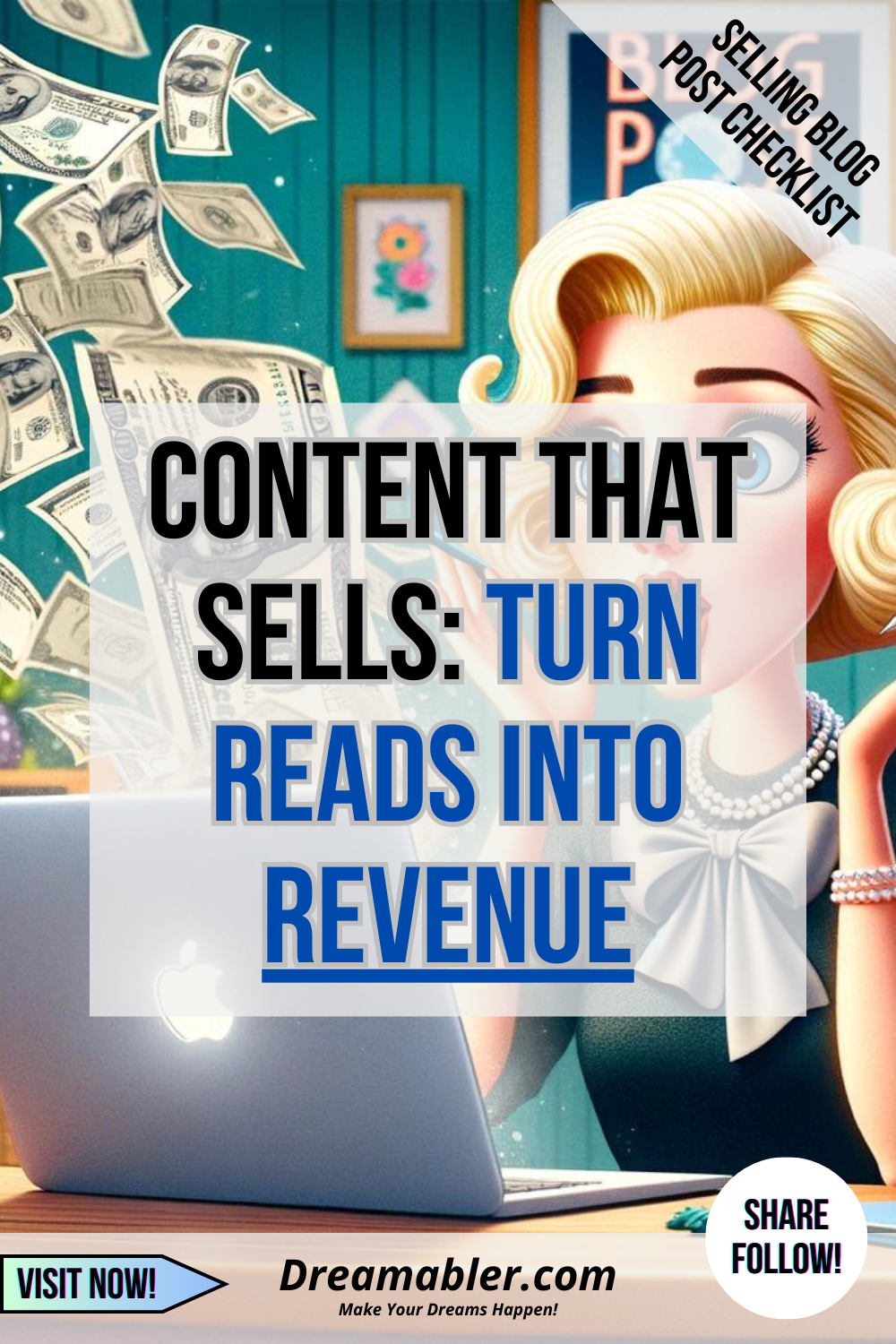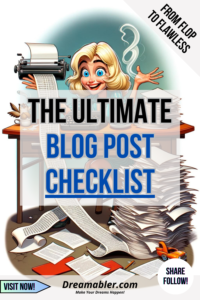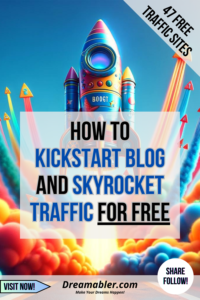In the bustling digital marketplace, where words are both currency and commerce, the power of content to transform casual readers into loyal customers cannot be understated.
“Content That Sells: Turn Reads Into Revenue” isn’t just a catchy phrase; it’s a clarion call to all digital creators, marketers, and entrepreneurs who seek to carve their niche in the ever-evolving online ecosystem.
Master the Art of Blog Posts That Convert
Imagine this: you’re strolling through the vast expanse of the internet, akin to wandering the aisles of an infinite library. Each blog post you encounter is a book, its cover vying for your attention.
What makes you pick one book over another? Is it the allure of the title, the promise of untold wisdom within, or perhaps the magnetic pull of relatability?
Now, transpose that scenario to your content creation strategy. Your blog isn’t just a collection of words; it’s a beacon, guiding potential customers through the fog of information overload to the shores of your business.
Engage and Convert: The Blogging Formula
The art of crafting content that sells is akin to weaving a spell. You must ensnare the reader with the very first sentence, captivating them with a narrative so compelling they can’t help but read on.
This isn’t about deploying a barrage of sales pitches or drowning your audience in a sea of adjectives. No, this is about storytelling, about painting a picture so vivid that your readers can see themselves in it. It’s about understanding the whispers of their desires and echoing them back in a symphony of words that resonates with their deepest needs.
Consider the entrepreneur who shares not just the triumphs but the trials of their journey, turning their blog into a tapestry of human experience. Or the marketer who understands that behind every click, behind every read, there’s a person seeking answers, entertainment, or escape.
By crafting content that addresses these intrinsic desires, that speaks directly to the heart of the reader, you’re not just selling a product or service; you’re offering a solution, a promise, a dream.
Authenticity – The Golden Rule of Content That Sells

Let’s not forget the secret ingredient: authenticity. In a world awash with content, genuine stories stand out like lighthouses in the night. When you infuse your writing with real-life anecdotes, with the laughter and tears of your own experiences, you transform your blog from a mere platform into a pulpit, from which you can preach the gospel of your brand.
This isn’t about fabricating tales; it’s about finding the extraordinary in the ordinary, the universal truths in personal stories.
Now, I hear you ask, “But how do I ensure my content not only captivates but converts?” The answer lies in the subtle art of call-to-action. It’s the gentle nudge after a riveting performance, the whispered invitation to continue the journey together.
Whether it’s a prompt to subscribe to a newsletter, a teaser of what’s to come, or a direct invitation to explore your products or services, your call-to-action should feel like the natural next step in the dance you’ve been leading.
As we weave through the tapestry of content creation, remember that each word you write is a thread in a larger narrative. You’re not just selling a product; you’re offering a key to a door yet unopened, a path yet untrodden.
“Content That Sells: Turn Reads Into Revenue” isn’t just a strategy; it’s a philosophy, a way of seeing the world not as a market, but as a community of souls hungry for stories that resonate, for content that not only informs but transforms.
The Perfect Selling Blog Post Checklist
Crafting content that not only captivates readers but also convinces them to take action is a nuanced art form, a delicate balance between persuasion and genuine connection.
Writing content that sells is like hosting a dinner party; you want to entice guests with the aroma, satisfy their hunger with the meal, and leave them reminiscing about the experience, eager to return.
Here’s what the perfect selling blog post should include, served up as a gourmet meal on a silver platter:
- Irresistible Headline: Your headline is the amuse-bouche, the tantalizing bite that makes the reader eager for more. It should promise value, evoke curiosity, or address a specific need that resonates with your target audience.
- Engaging Opening: Like a perfectly paired appetizer, your opening should complement the headline, drawing the reader further in. Start with a compelling hook—a surprising statistic, a relatable anecdote, or a provocative question.
- Relatable Anecdotes: Just as the main course offers depth and substance, your content should weave in stories that readers can see themselves in. These anecdotes humanize your message, making complex concepts digestible and memorable.
- Clear, Concise Value: The side dishes of your content meal—each point you make should offer clear value, enhancing the overall experience. Use bullet points or numbered lists to break down complex ideas, making them easy to understand and remember.
- Strong, Supportive Data: Like a robust sauce that ties the meal together, data and statistics lend credibility to your claims. They provide the evidence that what you’re offering isn’t just palatable but proven to satisfy.
- Visually Appealing Layout: Presentation matters in both fine dining and content creation. Use subheadings, images, and white space to make your content visually appealing, ensuring readers stay at the table, engaged and not overwhelmed.
- Persuasive Call-to-Action: Dessert is the sweet end to a meal, leaving a lasting impression. Your call-to-action should be persuasive, encouraging readers to take the next step, whether it’s subscribing, purchasing, or engaging further with your content.
- Engagement Opportunities: Finally, offer an after-dinner mint—the chance for readers to engage further. This could be through comments, sharing the content on social media, or exploring related articles. It keeps the conversation going and builds a community around your content.
Furthermore, it’s a good idea to pay attention to your content calendar, i.e., how often you post. According to HubSpot, the critical factor is the frequency of publishing. Bloggers who post 2-6 times weekly are 50% more likely to report strong results, underscoring the importance of consistent and regular content updates to maintain reader interest and engagement.
Another interesting thing I wish to share is the importance of interactive elements, i.e., videos on blog posts. According to Backlinko, incorporating video into blog posts can significantly enhance engagement, as videos are shared on social media 12 times more than text and images combined, and they can help businesses grow their revenue 49% faster compared to non-video users.
Creating content that sells is about more than just the ingredients; it’s about how you blend them together to create an experience that delights, informs, and, most importantly, converts. The goal is not just to feed your readers but to whet their appetite for more, turning casual browsers into loyal patrons of your brand.
Let’s Write Blog Posts That Convert!
In the end, the true measure of content that sells is not just in the revenue it generates but in the connections it fosters, the lives it touches, and the communities it builds. Take a look also on my The Ultimate Blog Post Checklist to get more valuable ideas!
So, write not just to sell, but to serve, not just to convince, but to connect. For in the heart of every reader lies not just a potential customer, but a human being yearning for a story that speaks to them. And when you turn reads into revenue, you do so not by the might of your sales pitch, but by the power of your prose.
And there you have it, the recipe for content that not only dazzles but delivers. Now, if you’ve found value in this journey we’ve taken together, I’ve got a little favor to ask.
Subscribe and follow me to stay updated with more insights like these. Your thoughts fuel my passion, so don’t hesitate to post your comments below. Let’s start writing blog posts that make your dreams come true. Dive in, the world of content awaits!
Frequently Asked Questions
⭐️ Can I still sell through my content without directly promoting my products?
Absolutely! In fact, soft selling by providing immense value and establishing yourself as an authority in your field can be more effective than hard-selling tactics. Educate, entertain, and inspire your readers, and they’ll naturally gravitate towards your offerings.
⭐️ How often should I update my blog to effectively sell my product or service?
Consistency is key in blogging. Aim for a frequency that maintains quality and relevance—whether that’s weekly, bi-weekly, or monthly. The focus should be on providing value in every post, not just the quantity of posts.
⭐️ How important is SEO in writing content that sells?
SEO is crucial as it helps your content get discovered by a wider audience. Use relevant keywords, meta descriptions, and tags to improve your blog post’s visibility on search engines, but always prioritize natural and engaging writing.
⭐️ Should I focus on trends or evergreen content for selling through my blog?
A mix of both is ideal. While trending topics can attract immediate attention, evergreen content remains relevant and continues to drive traffic over time. Balancing the two ensures a steady stream of readers.
⭐️ Should I focus on trends or evergreen content for selling through my blog?
A mix of both is ideal. While trending topics can attract immediate attention, evergreen content remains relevant and continues to drive traffic over time. Balancing the two ensures a steady stream of readers.
⭐️ How can I measure the success of my selling blog posts?
Use analytics tools to track metrics such as page views, time spent on page, bounce rate, and conversion rates. These insights can help you understand what resonates with your audience and adjust your strategy accordingly.
⭐️ Is it necessary to have a call-to-action in every blog post?
While not every post needs a direct sales pitch, including a soft call-to-action, such as inviting comments, sharing, or reading another related post, keeps the reader engaged and encourages them to explore more of your content.
#ContentMarketing #BloggingForBusiness #EngageToConvert #StorytellingSells #DigitalMarketingTips #CustomerConversion #ContentThatConverts





